Subscribe to our newsletter

Watch Video: Top -10 Historic Shrines and Temples in Tokyo
Welcome to a captivating exploration of Tokyo's top 10 historic shrines and temples, where ancient traditions and spiritual sanctuaries coexist amidst the bustling urban landscape. Tokyo, a city deeply rooted in its cultural heritage, offers visitors a chance to journey through time and witness the sacred spaces that have stood the test of centuries. From Senso-ji Temple, the oldest and most revered Buddhist temple, to the Imperial Palace, a symbol of Japan's imperial heritage, each location holds its unique historical and cultural significance. Join us on this sacred journey as we unveil the secrets, traditions, and architectural wonders that make these sites cherished landmarks of Tokyo.
Blog navigation
1. Senso-ji Temple: The Ancient Guardian of Asakusa
Located in the heart of Asakusa, Senso-ji Temple is Tokyo's oldest and most renowned Buddhist temple. Its vibrant Thunder Gate, or Kaminarimon, welcomes visitors to a bustling street filled with traditional shops and street food stalls leading to the temple's main hall. With its rich history dating back to the 7th century, Senso-ji offers a profound sense of spirituality and an authentic glimpse into Japan's cultural heritage.
- Address: 2-3-1 Asakusa, Taito City, Tokyo 111-0032
- How to get there: Take the Tokyo Metro Ginza Line to Asakusa Station (Exit 1) or the Tobu Skytree Line to Asakusa Station (Exit 1 or 3).
- Opening Hours: Main Hall: 6:00 AM to 5:00 PM (6:30 AM to 5:00 PM from October to March)
- Historical & Cultural Significance: Tokyo's oldest temple, founded in 628 AD, dedicated to Kannon, the Buddhist goddess of mercy. It survived wars and earthquakes, preserving its traditional architecture.
- Best Known For: The vibrant Thunder Gate (Kaminarimon), bustling Nakamise shopping street, and the annual Sanja Matsuri festival.
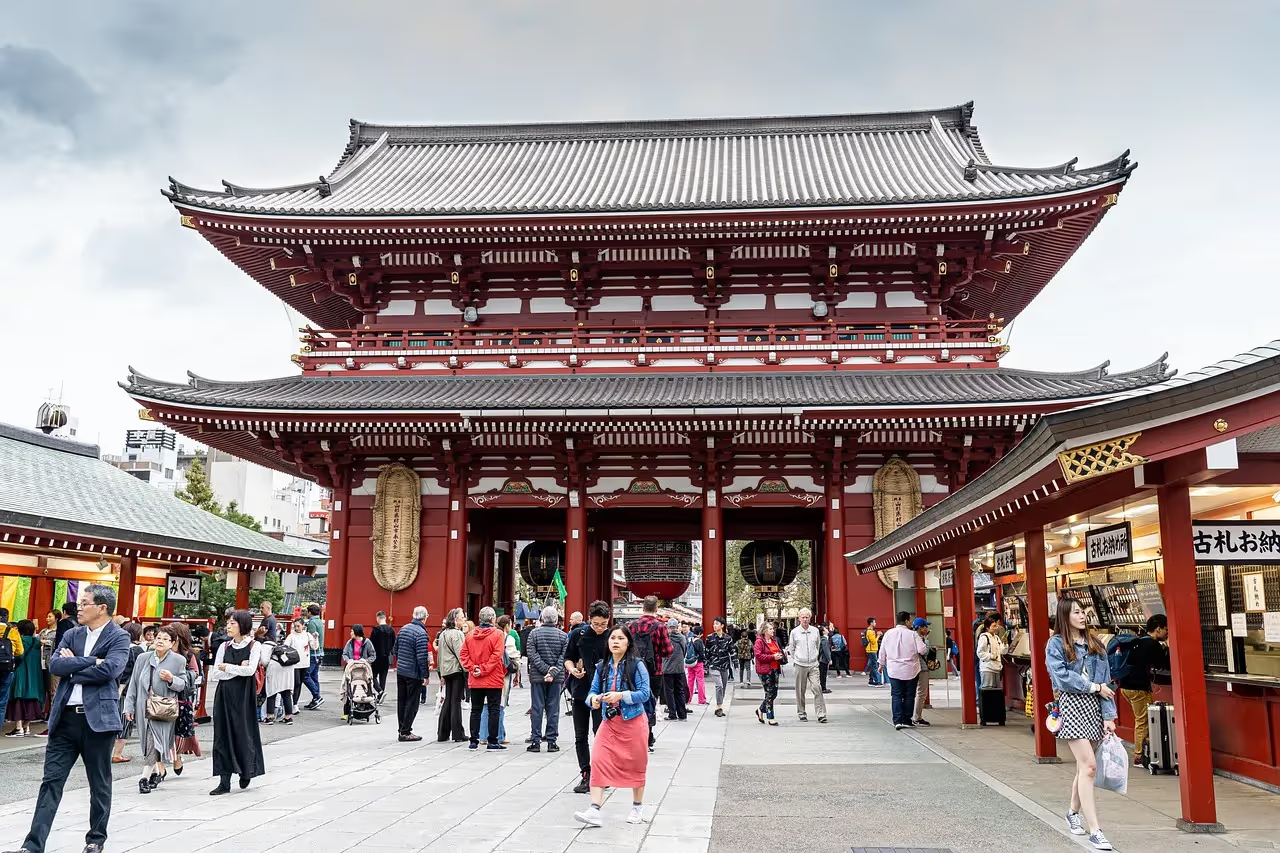
2. Meiji Shrine: A Forest Sanctuary Amidst the Urban Bustle
Nestled within a serene forest in Shibuya, Meiji Shrine honors Emperor Meiji and Empress Shoken, offering a peaceful retreat from Tokyo's modern chaos. As you walk through towering torii gates and lush greenery, the majestic Meiji Shrine unveils itself. The atmosphere here radiates tranquility and reverence, making it a popular place for locals and tourists alike to seek solace and pay their respects.
- Address: 1-1 Yoyogikamizonocho, Shibuya City, Tokyo 151-8557
- How to get there: Take the Tokyo Metro Chiyoda Line or Fukutoshin Line to Meiji-jingu Mae Station, or JR Yamanote Line to Harajuku Station.
- Opening Hours: Sunrise to sunset (varies each month)
- Historical & Cultural Significance: Built in 1920, dedicated to Emperor Meiji and Empress Shoken, promoting Shinto rituals and preserving ancient traditions.
- Best Known For: Its vast forested grounds, elegant torii gates, and traditional wedding ceremonies.
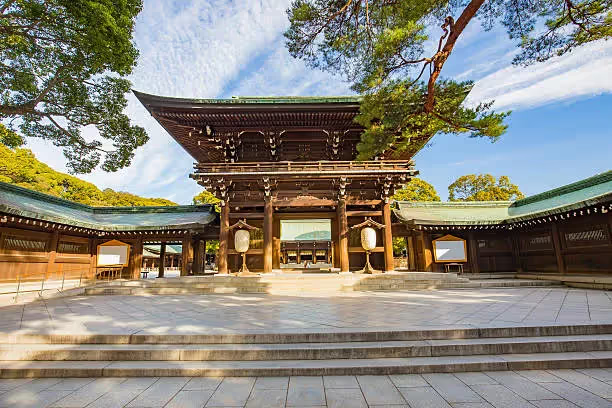
3. Asakusa Shrine: The Protector of Senso-ji Temple
Asakusa Shrine, also known as Sanja-sama, stands adjacent to Senso-ji Temple and serves as its guardian. This Shinto shrine holds annual festivals that draw millions of visitors, featuring traditional mikoshi (portable shrines) parades and energetic festivities. Its historic significance and vibrant events make it a lively and important part of Tokyo's cultural landscape.
- Address: 2-3-1 Asakusa, Taito City, Tokyo 111-0032
- How to get there: Located adjacent to Senso-ji Temple (see details above).
- Opening Hours: 9:00 AM to 4:30 PM (may vary during festivals)
- Historical & Cultural Significance: Protects Senso-ji Temple and houses three Shinto deities. It plays a crucial role in the Sanja Matsuri festival.
- Best Known For: Being a Shinto counterpart to Senso-ji Temple, attracting visitors during major festivals.

4. Nezu Shrine: A Vermilion Oasis of Tradition and Nature
Nestled in Bunkyo, Nezu Shrine boasts a stunning vermilion-colored bridge and a captivating tunnel of torii gates enveloped by a peaceful Japanese garden. This hidden gem provides a serene escape from the city, inviting visitors to experience traditional tea ceremonies and admire its beautiful azalea blooms during the spring season.
- Address: 1-28-9 Nezu, Bunkyo City, Tokyo 113-0031
- How to get there: Take the Tokyo Metro Chiyoda Line to Nezu Station (Exit 1) or Sendagi Station (Exit 2).
- Opening Hours: 9:00 AM to 5:00 PM
- Historical & Cultural Significance: Founded in the 1st century, renowned for its azalea festival and well-preserved Edo-period architecture.
- Best Known For: The stunning tunnel of torii gates and serene traditional garden.
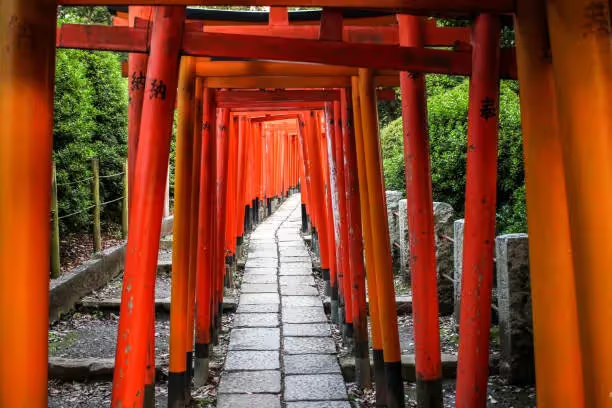
5. Zojoji Temple: A Gateway to the Afterlife
Standing against the backdrop of Tokyo Tower in Minato, Zojoji Temple represents one of Tokyo's key Buddhist temples. Originally a burial site for the Tokugawa shoguns, the temple's main hall and impressive wooden gate offer glimpses into Japan's feudal history. Visitors can also partake in unique customs, such as Jizo-bon, a compassionate ritual for deceased children.
- Address: 4-7-35 Shibakoen, Minato City, Tokyo 105-0011
- How to get there: Take the Toei Mita Line or Tokyo Metro Nanboku Line to Shibakoen Station (Exit A1).
- Opening Hours: 9:00 AM to 5:00 PM (closes at 4:30 PM in winter)
- Historical & Cultural Significance: Built in 1393, formerly a mausoleum for Tokugawa shoguns, now offers prayers for the departed.
- Best Known For: Jizo-bon ritual, stunning wooden gate, and its role as a Tokugawa family temple.
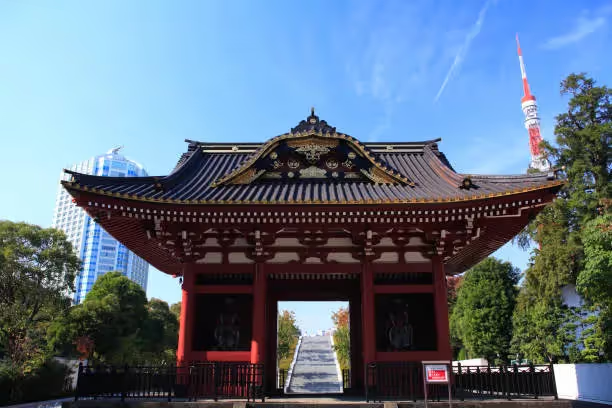
6. Kanda Myojin Shrine: Where Tradition Meets Modernity
Situated in Chiyoda, Kanda Myojin Shrine is a fascinating blend of ancient rituals and contemporary elements. Often frequented by locals praying for business success and technological advancements, this shrine showcases colorful festival processions and a lively atmosphere during seasonal celebrations.
- Address: 2-16-2 Sotokanda, Chiyoda City, Tokyo 101-0021
- How to get there: Take the Tokyo Metro Ginza Line to Suehirocho Station (Exit 4) or Ochanomizu Station (Exit A1).
- Opening Hours: 9:00 AM to 5:00 PM (varies during festivals)
- Historical & Cultural Significance: Originating in the 8th century, known for blessings in business and technology.
- Best Known For: The vibrant Kanda Festival and its connection to modern subcultures.
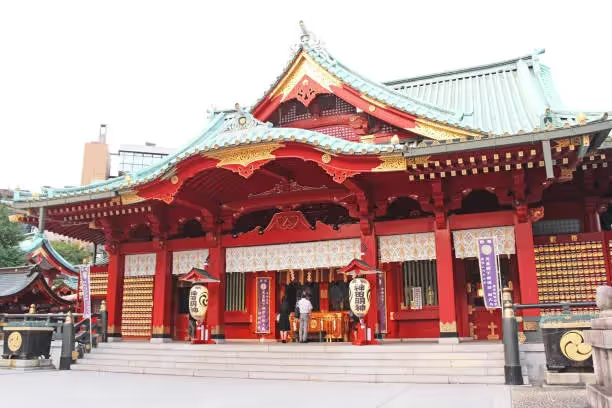
7. Yasukuni Shrine: Memorializing the Souls of War Heroes
Located in Chiyoda, Yasukuni Shrine has sparked both reverence and controversy as it commemorates the souls of those who died in service of Japan during war. The Yushukan Museum on its grounds houses artifacts and exhibits related to Japan's military history, offering insight into the nation's complex past.
- Address: 3-1-1 Kudankita, Chiyoda City, Tokyo 102-8246
- How to get there: Take the Tozai Line or Hanzomon Line to Kudanshita Station (Exit 1).
- Opening Hours: 6:00 AM to 5:00 PM (closes at 4:30 PM in winter)
- Historical & Cultural Significance: Established in 1869, honors Japan's war dead, including controversial war criminals.
- Best Known For: Annual controversial visits by politicians and the Yushukan Museum's military exhibits.

8. Hie Shrine: An Edo-Era Religious Citadel
Overlooking Tokyo from a hill in Chiyoda, Hie Shrine has a history dating back to the 14th century. Known for its vibrant Sanno Festival, it attracts visitors with processions featuring elaborately decorated portable shrines carried through the streets, adding an electrifying energy to the city's traditional landscape.
- Address: 2-10-5 Nagatacho, Chiyoda City, Tokyo 100-0014
- How to get there: Take the Tokyo Metro Chiyoda Line or Namboku Line to Nagatacho Station (Exit 7).
- Opening Hours: 6:30 AM to 6:00 PM (closes at 5:00 PM in winter)
- Historical & Cultural Significance: Founded in 1478, played a significant role in Edo-era festivals and ceremonies.
- Best Known For: The lively Sanno Festival featuring colorful processions and mikoshi parades.

9. Imperial Palace: The Resplendent Residence of Emperors
Situated amidst sprawling gardens in Chiyoda, the Imperial Palace is the primary residence of the Emperor of Japan. Although not a religious shrine, the palace and its serene surroundings provide a glimpse into Japan's imperial heritage and offer limited public access on special occasions.
- Address: 1-1 Chiyoda, Tokyo 100-8111
- How to get there: Take the Tokyo Metro Chiyoda Line to Nijubashimae Station (Exit 2) or Tozai Line to Takebashi Station (Exit 1B).
- Opening Hours: Public areas accessible on special occasions, such as the Emperor's Birthday (December 23) and New Year.
- Historical & Cultural Significance: Served as a residence for the Imperial family since 1868, reflecting Japan's imperial heritage.
- Best Known For: The traditional Nijubashi Bridge and its role in official imperial ceremonies.

10. Ginza Wako Shrine: Where Commerce and Spirituality Converge
Nestled in the bustling shopping district of Ginza, the Ginza Wako Shrine stands as a unique fusion of commercial prosperity and spiritual reverence. Known for its guardian deity of commerce, this small but culturally significant shrine is a testament to Tokyo's harmonious blend of tradition and modernity.
- Address: 4-5-11 Ginza, Chuo City, Tokyo 104-0061
- How to get there: Take the Tokyo Metro Ginza Line to Ginza Station (Exit A5) or Higashi-Ginza Station (Exit A7).
- Opening Hours: 24/7 (outdoor shrine accessible at all times)
- Historical & Cultural Significance: Established in the early 1900s by a prominent jeweler, blending commerce with spiritual beliefs.
- Best Known For: Its guardian deity of commerce, attracting businessmen and entrepreneurs seeking prosperity.
NOTE: Please note that the provided durations are approximate and can vary depending on various factors. It is recommended to contact the respective hot air balloon companies directly for the most accurate and up-to-date information.
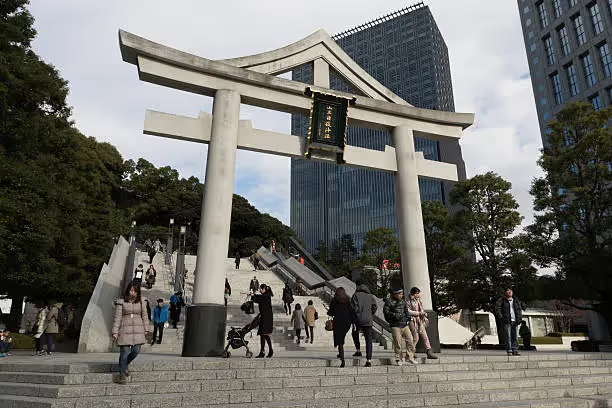
Conclusion
As our sacred journey through Tokyo's top 10 historic shrines and temples comes to a close, we find ourselves enriched with a deeper understanding of Japan's cultural heritage. These revered places of worship, steeped in history and spirituality, offer a glimpse into the country's storied past and its enduring traditions. From the ancient charm of Senso-ji Temple to the serene allure of Meiji Shrine, each site has left an indelible mark on Tokyo's cultural landscape.
As visitors walk through vibrant torii gates, immerse themselves in lively festivals, and experience the harmonious blend of tradition and modernity, they become part of the ever-evolving narrative of Tokyo's spiritual journey. These historic shrines and temples remain not only symbols of Japan's ancient legacy but also enduring reflections of its rich cultural identity.
We hope this exploration has inspired you to embark on your own sacred journey, where you can uncover the hidden gems and profound spirituality that lie within Tokyo's heart. Whether you seek solace, historical insights, or simply the beauty of architectural marvels, Tokyo's shrines and temples stand ready to welcome you with open arms and a sense of timeless wonder.

















